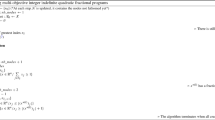Abstract
In this paper a deterministic method is proposed for the global optimization of mathematical programs that involve the sum of linear fractional and/or bilinear terms. Linear and nonlinear convex estimator functions are developed for the linear fractional and bilinear terms. Conditions under which these functions are nonredundant are established. It is shown that additional estimators can be obtained through projections of the feasible region that can also be incorporated in a convex nonlinear underestimator problem for predicting lower bounds for the global optimum. The proposed algorithm consists of a spatial branch and bound search for which several branching rules are discussed. Illustrative examples and computational results are presented to demonstrate the efficiency of the proposed algorithm.
Similar content being viewed by others
References
Al-Khayyal, F.A. (1992), Generalized bilinear programming: Part I. Models, applications and linear programming relaxation,European Journal of Operational Research 60, 306–314.
Al-Khayyal, F.A. and Falk, J.E. (1983), Jointly constrained biconvex programming,Mathematics of Operations Research 8, 273–286.
Bazaraa, M.S. and Shetty, C.M. (1979),Nonlinear Programming Theory and Algorithms, John Wiley & Sons, New York.
Charnes, A. and Cooper, W.W. (1962), Programming with linear fractional functionals,Naval Research Logistics Quarterly 9, 181–186.
Dinkelbach, W. (1967), On nonlinear fractional programming,Management Science 13, 492–498.
Falk, J.E. and Palocsay, S.W. (1992), Optimizing the sum of linear fractional functions,Recent Advances in Global Optimization, in Floudas, C.A and Pardalos, P.M. (eds.), 221–258.
Floudas, C.A. and Pardalos, P.M. (1990),A Collection of Test Problems for Constrained Global Optimization Algorithms, G. Goss and J. Hartmanis (eds.), Springer Velag.
Floudas, C.A. and Visweswaran, V. (1990), A global optimization algorithm (GOP) for certain classes of nonconvex NLPs-I Theory,Computers Chem. Engng. 14, 1397–1417.
Grossmann, I.E. (1990), Mixed-Integer Non-Linear Programming Techniques for the Synthesis of Engineering System,Res. Eng. Des. 1, 205–228.
Horst, R. (1990), Deterministic methods in constrained global optimization: Some recent advances and fields of application,Naval Research Logistics 37, 433–471.
Horst, R. and Tuy, T. (1990),Global Optimization: Deterministic Approaches, Springer-Verlag, Berlin, New York.
Konno, H., Yajima, Y. and Matsui, T. (1991), Parametric Simplex Algorithms for Solving a Special Class of Nonconvex Minimization Problems.Journal of Global Optimization 1, 65–81.
Lasdon, L.S., Waren, A.D., Sarkar, S., and Palacios, F. (1979), Solving the Pooling Problem Using Generalized Reduced Gradient and Successive Linear Programming Algorithms,SIGMAP Bull 77, 9–15.
Liebman, J., Lasdon, L., Schrage, L., and Waren, A. (1986),Modelling and Optimization with GINO, The Scientific Press, Palo Alto, CA.
Lo, C. and Papalambros, P.Y. (1990), A Deterministic Global Design Optimization Method for Nonconvex Generalized Polynomial Problems,Advances in Design Automation, New York.
McCormick, G.P. (1976), Computability of Global Solutions to Factorable Nonconvex Programs: Part I — Convex Underestimating Problems,Mathematical Programming,10, 146–175.
Papalambros, P. and Wilde, D.L. (1988),Principles of Optimal Design: Modelling and Computation, Cambridge University Press, Cambridge.
Quesada, I. and Grossmann, I.E. (1993), Global optimization algorithm for heat exchanger netwoks.Ind. Eng. Chem. Res.,32. 487–499.
Quesada, I. and Grossmann, I.E. (1995), Global optimization of process networks with multicomponent flows. To appear inComputers and Chem. Eng.
Reklaitis, G.V. and Ravindran, A. (1983),Engineering Optimization: Methods and Applications. Wiley, New York.
Sahinidis, N.V. and Grossmann, I.E. (1991), Convergence Properties of Generalized Benders Decomposition.Computers and Chem. Eng. 15, 481–491.
Schoen, F. (1991), Stochastic Techniques for Global Optimization: A Survey of Recent Advances.Journal of Global Optimization 1, 207–228
Sherali, H.D. and Alameddine, A. (1992), A new reformulation-linearization technique for bilinear programming problems,Journal of Global Optimization 2, 379–410.
Swaney, R.E. (1993), Global solution of algebraic nonlinear programs. Paper MC36.3 presented at TIMS/ORSA meeting, Phoenix, AZ.
Visweswaran, V. and Floudas, C. A. (1990), A global optimization algorithm (GOP) for certain classes of nonconvex NLPs-II Application of theory and test problems,Computers Chem. Engng. 14, 1419.
Visweswaran, V. and Floudas, C.A. (1991), Global optimization of problems with polynomial functions in one variable.Recent Advances in Global Optimization, in Floudas, C.A and Pardalos, P.M. (eds.), 165–199.
Author information
Authors and Affiliations
Rights and permissions
About this article
Cite this article
Quesada, I., Grossmann, I.E. A global optimization algorithm for linear fractional and bilinear programs. J Glob Optim 6, 39–76 (1995). https://doi.org/10.1007/BF01106605
Received:
Accepted:
Issue Date:
DOI: https://doi.org/10.1007/BF01106605




